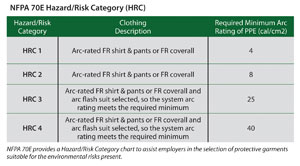Prior to selecting suitable safeguards, facility managers must assess the potential dangers associated with each industrial application for tailored safety  solutions. By providing appropriate personal protective equipment (PPE), employers will not only protect against costly injuries, but also increase productivity, reduce unnecessary downtime and avoid potential liability.
solutions. By providing appropriate personal protective equipment (PPE), employers will not only protect against costly injuries, but also increase productivity, reduce unnecessary downtime and avoid potential liability.
Dangers of arc flash
One of the primary safety risks in industrial environments is electrical arc flash. Arc flash is an explosive blast of flame, debris, sounds and force, reaching up to 35,000°F in less than one second. Easily ignited, the causes of arc flash are diverse and often uncontrollable, including accidental contact with an energized part, contamination from dust or wiring errors, each creating a spark that creates a dangerous burst of flames.
With as many as ten arc flash injuries occurring every day in the U.S., there are a wide range of potential consequences, including third degree burns, blindness, nerve damage, cardiac arrest and even death. To prevent harm, workers who perform duties that could result in arc flash conditions should wear flame-resistant apparel.
Personal protective equipment
PPE is necessary to protect against injuries resulting from contact with chemical, physical, mechanical, electrical hazards and more. Utilizing various equipment, including goggles, gloves, hard hats, facemasks and flame-resistant apparel, enables employees to protect their eyes, limbs, skin and lungs from a wide range of industrial risks.
Assessing the unique safety challenges present in each industrial environment is a crucial component for selecting PPE. Completing an assessment using NFPA 70E electrical workplace safety guidelines will aid employers in categorizing and understanding their existing electrical hazards. By knowing the risks, employers can effectively protect their employees from injury with application-specific PPE.
To safeguard against electrical dangers, such as arc flash, utilizing PPE like flame-resistant apparel can provide the precise level of protection needed to ensure employees are safe without impacting productivity.
Flame-resistant apparel
Flame-resistant apparel is separated into distinct Hazard/Risk Categories, offering an easy-to-follow guide for selecting clothing. Categorizing protective apparel ensures the proper protective gear is used for the appropriate hazard. Ranked from HRC levels one through four, each category offers information regarding types of apparel and energy calorie levels for a simple reference guide to proper protection standards. The chart below illustrates Hazard/Risk Category requirements for flame-resistant apparel.
Flame-resistant apparel can be further broken down into primary and secondary protective clothing. Primary protective equipment is used when the worker is aware of a high likelihood of exposure to hazards, such as repairing equipment with high voltage ratings. Primary falls within HRC levels three and four, requiring employees to be fully protected with a flash suit. Secondary protective apparel guards against the most common risks, HRC 2, with ratings between 8 and 24 calories of energy. By wearing a flame-resistant shirt/pant combination or coveralls, workers are sufficiently protected. Further, depending on the application, additional equipment may be necessary, including volt-rated gloves, goggles, and in some cases, a head covering for increased safety.
In the field
In any industry, one of the most dangerous jobs is performing equipment maintenance. Often this requires working near live machines or energized parts — increasing the risk of arc flash, thereby escalating the likelihood of injury. However, performing maintenance is an essential function for sustaining plant productivity.
When a piece of equipment requires maintenance, if possible, the machine should be powered down to protect employees and equipment from damage. When it has not been turned off, an arc flash can be ignited by actions as simple as dropping a tool or placing it is the wrong location, causing a spark that quickly leads to flames.
At times, a worker performs near a live part, where the margin for error is minute. Removing or installing circuit breakers, low voltage testing and unbolting equipment covers can all lead to arc flash hazards. Any accidental contact with an energized part or other miscalculations can quickly ignite arc blasts, instantaneously burning anything or anyone in its path. By implementing proper industrial safety measures, such as flame-resistant apparel, workers are better protected from the devastating injuries resulting from arc flash and other threatening conditions.


